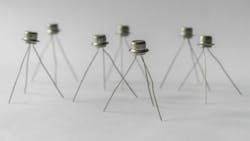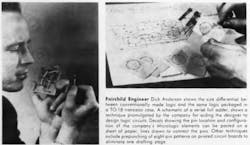For Designers: Logic Nets in Transistor Cans (ED article from 1961)
Five Companies Packaging Logic Circuitry In Conventional TO-5, -18 Transistor Cans
March 29, 1961 - LOGICAL microcircuits in transistor cans are now being offered by four major companies. Heavy research and production is being pressed by Fairchild Semiconductor Corp., Raytheon Co., Philco Corp., General Instrument Corp., and Sperry Gyroscope’s Semiconductor Div.
Fairchild and Raytheon are currently selling evaluation quantities of the first logical elements in their respective six-block lines—a Micrologic flip flop by Fairchild and a NOR logic circuit by Raytheon. Both logical elements are packaged in TO-5 and TO-18 cans.
Philco is expected to be in production shortly on preliminary transistor-diode “logic pacs.” Sperry Semiconductor Div. is in pilot production on Semi-Net NOR circuits in TO-5 cases. Units are so far only for internal evaluation.
A General Instrument Corp, full adder comprising seven TO-5 cans will be available in evaluation quantities during April. TO-circuit modules will be used as functional blocks to build up logic circuits such as shift registers and adders. A one-bit section of shift register might contain six gate TO-circuits and two flip flops. Three half-adder cans, two half-shift registers cans and a gate can could make a serial full adder. TO-circuit modules may be made by vacuum deposition techniques or by combining microresistors and other passive components with a transistor, all within the transistor package. Eight pins are standard so far for the TO-circuit package. Other manufacturers have been pursuing other techniques. TI, Westinghouse, and Burroughs, for example, have micro-circuits in a variety of configurations.
The TO-circuit represents a different marketing approach. “Computer manufacturers may soon be able to realize a 90-per-cent reduction in size and a 70- per-cent reduction in cost of the logic section of a computer,” states Dr. Robert N. Noyce, vice president of Fairchild Semiconductor Corp. At the evaluation-quantity price of $120 for a Micrologic flip flop, he points out, the unit is a break-even item. It costs about as much as a conventional flip flop—counting component cost, assembly cost and logic design. But, Dr Noyce adds, in production quantities the cost of Micrologic elements will fall rapidly, reaching $8.00 or so in a few years.
In the TO-5 can, Micrologic blocks can be used with conventional printed-circuit boards; in the TO-18 package its application will be in welded-wire interconnections. Fairchild announced the first element of the Micrologic family, a flip flop, at the IRE Show in New York. Other members of the family, to follow within the year, include half-shift registers, gates, buffers, half adders and counter adapters. Using these six Micrologic elements, the entire logic section of a digital computer or control system could be built. According to Dr. Noyce, Micrologic elements are fundamentally more reliable than conventional computer circuits. The internal interconnections—leads bonded by thermal compression techniques—are more reliable than the analogous printed-circuit-board interconnections.
Tailor-Made Layout Eases Logic Design
In an effort to capture the computer market, Fairchild is concentrating heavily on easing the logic designer’s load. Micrologic pattern decals are supplied to the designer: all he [yes, that’s the language of those days] has to do is peel them off the paper backing and stick them on his drawing paper, then connect the pins as in the photograph. Arrangements are being made with printed-circuit manufacturers to supply boards drilled with the eight-pin pattern. All the computer manufacturer has to do is connect the pins with printed wiring. One complete design step is eliminated.
Fairchild Micrologic cans are supplied according to standard specifications; the engineer must design his circuit according to them. He will not be able to order a variety of off-the-shelf variations except at a premium. Fairchild’s flip flop, for example, requires a supply voltage of +3 vdc ±30 per cent. Power dissipation is typically 30 mw and operates in temperatures from —55 C to +125 C. Input is designed to be driven by any Micrologic element. Load is one Micrologic element. Output can drive up to four other Micrologic elements loads in parallel, the company reports.
Fairchild uses npn transistors in DCTL configuration [for 1963’s CMOS chips by Fairchild, click here]. Made by diffusing the transistors and resistors for many units into a single slab of silicon, the Micrologic elements are said to have good reliability and are potentially inexpensive. Internal metallic interconnections are deposited on top of the slab and the slab is cut into individual elements.
In contrast to Fairchild’s theory that low price and maximum effectiveness can be realized only by marketing a standard “take-it-or-leave-it” logic function, Raytheon Co. is planning to sell both standard and special NOR circuits to the computer designer. Currently being sold in evaluation quantities at a “negotiable’’ price, the Raytheon NOR circuit is packaged in a TO-5 case. A conventional alloying technique provides the gate diodes; a post-alloy diffusion process is used for the fabrication of the RC network. A bias resistor is constructed from a thin diffused layer. With a cut-off frequency of 30 mc [megacycles, aka MHz], the npn transistor is loaded by a 1-K resistor.
Philco To Make TO-Circuits By Diffusion or Assembly
According to Philco’s Semiconductor R&D Director C. G. Thornton, the company will undertake, on special order, either to microminiaturize existing computer logic circuitry, or, like Fairchild and Raytheon, sell standard diffusion-process units. “The designer just can’t take a circuit breadboarded with conventional components and use the same design in diffused silicon microcircuitry,” says Dr. Thornton. The semiconductor resistor, for example, may change value with a change in temperature. For the time being, Philco will investigate depositing resistances on a separate substrate. General Instrument Corp.’s technique is to interconnect conventional microcomponents within a TO-5 can. At Sperry Semiconductor Div., special TO circuit units are being supplied to the Univac Div. No units are being sold outside the company, according to a spokesman.
This article first appeared in the March 29, 1961 edition of Electronic Design magazine, as written by Thomas E. Mount, and is presented as a companion article to AndyT’s Nonlinearities blog.
For more timely show coverage than waiting 62 years like for the IRE show in NYC, please check out our CES 2025 coverage, with Electronic Design’s editors on the show floor in Las Vegas.
AndyT's Nonlinearities blog arrives the first and third Monday of every month. To make sure you don't miss the latest edition, new articles, or breaking news coverage, please subscribe to our Electronic Design Today newsletter.
About the Author
Andy Turudic
Technology Editor, Electronic Design
Andy Turudic is a Technology Editor for Electronic Design Magazine, primarily covering Analog and Mixed-Signal circuits and devices. He holds a Bachelor's in EE from the University of Windsor (Ontario Canada) and has been involved in electronics, semiconductors, and gearhead stuff, for a bit over a half century.
"AndyT" brings his multidisciplinary engineering experience from companies that include National Semiconductor (now Texas Instruments), Altera (Intel), Agere, Zarlink, TriQuint,(now Qorvo), SW Bell (managing a research team at Bellcore, Bell Labs and Rockwell Science Center), Bell-Northern Research, and Northern Telecom and brings publisher employment experience as a paperboy for The Oshawa Times.
After hours, when he's not working on the latest invention to add to his portfolio of 16 issued US patents, he's lending advice and experience to the electric vehicle conversion community from his mountain lair in the Pacific Northwet[sic].
AndyT's engineering blog, "Nonlinearities," publishes the 1st and 3rd monday of each month. Andy's OpEd may appear at other times, with fair warning given by the Vu meter pic.


